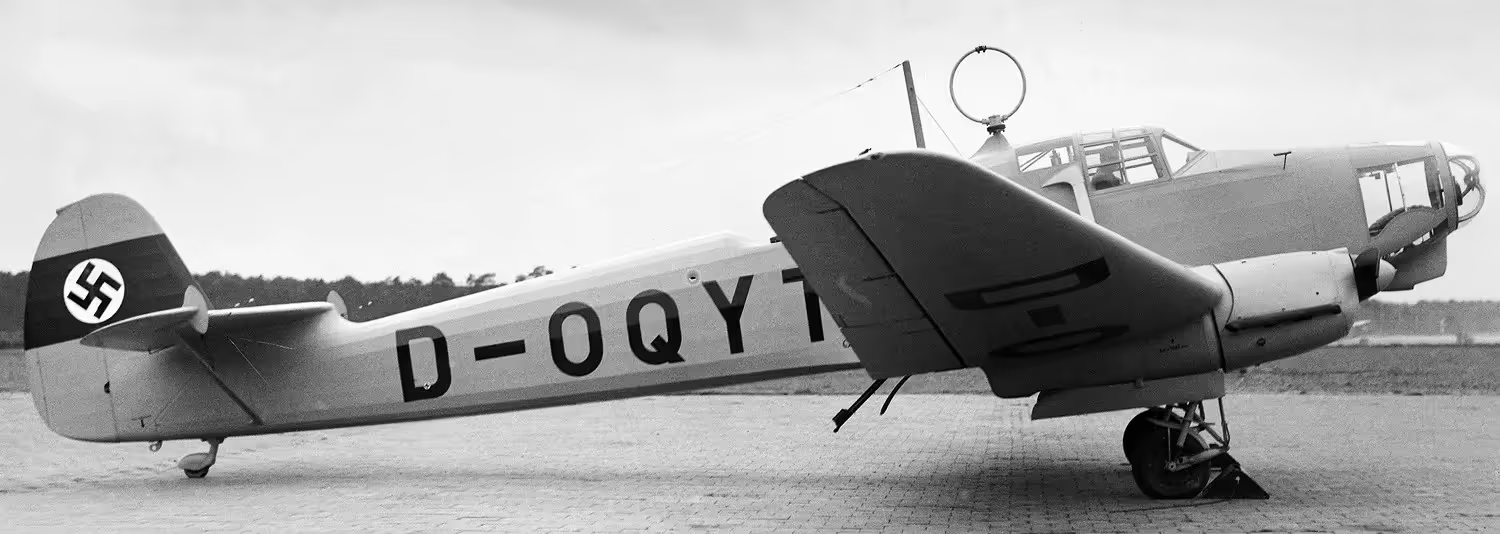Warplanes of Germany: Luftwaffe Focke-Wulf Fw 58 Weihe
Focke-Wulf Fw 58 Weihe, transport/trainer.

(Asisbiz Photo)
Focke-Wulf Fw 58 Weihe, transport/trainer.
The Focke-Wulf Fw 58 Weihe (Harrier) was a twin-engine multi-role aircraft designed and produced by the German aircraft manufacturer Focke-Wulf.It was developed in response to a request from the Luftwaffe, which sought a multi-role aircraft that could be operated as an advanced trainer for pilots, gunners and radio operators alike. The resulting Fw 58 was a low-wing monoplane powered by a pair of Argus As 10C V-8 piston engines mounted in nacelles on the wing's leading edges. The crew were seated under an enclosed canopy. Aft of the flight deck, the fuselage was open to form a moveable MG 15 machine gun station. The tailwheel undercarriage was retractable. The nose could either be glazer or faired over. The first prototype performed its maiden flight in 1935; the Fw 58 entered regular service two years later.
The Fw 58 was procured in large numbers by the Luftwaffe and thus was widely used across Germany for the training of several categories of military personnel. Furthermore, the type was routinely operated in other capacities, including as a VIP transport, air ambulance, feeder airliner, photo reconnaissance and weather research aircraft.[1] It was also operated as an airliner by the German flag carrier Deutsche Luft Hansa. Several were owned by private pilots, including the aeronautical engineer Kurt Tank. Outside of Germany, the type was built under license by several other nations, including Bulgaria, Hungary and Brazil. Other nations that procured the Fw 58 included the Netherlands, Romania, Croatia and Turkey.
A major customer for the Fw 58 was the Luftwaffe, a large number of its operational units were equipped with multiple aircraft, either Fw 58Bs or Fw 58Cs, for light transport and communications purposes. The type would see use as an air ambulance and several other secondary roles, including aerial application for agricultural products. At least 30 specially configurated Fw 58s were deployed to the Eastern Front to spray potential sources of disease for German ground forces.Between 1938 and 1939, eight aircraft in an airliner were supplied to the German flag carrier Deutsche Luft Hansa. Furthermore, a few aircraft were used for various experimental purposes, including early trials of aerial refuelling apparatus. Numerous private pilots, including the aeronautical engineer Kurt Tank (who had headed the design of the Fw 58), operated the type as a personal aircraft. (Wikipedia)
The only Fw 58 on display is at Museu Aeroespacial in Rio de Janeiro, Brazil. Brazil used this airplane mainly for maritime patrols and the example on display was one of the 25 Fw 58B-2 units license-built in Brazil by Fábrica de Galeão, circa 1941. An Fw 58 C-2 is stored in the Norwegian Aviation Museum in Bodø.

(Asisbiz Photo)
Focke-Wulf Fw 58 Weihe, transport/trainer.

(Luftwaffe Photo)
Focke-Wulf Fw 58 Weihe.

(Nederlands Instituut voor Militaire Historie Photo)
Focke-Wulf Fw 58 Weihe.

(Luftwaffe Photo)
Focke-Wulf Fw 58 Weihe.

(Asisbiz Photo)
Focke-Wulf Fw 58 Weihe.

(Luftwaffe Photo)
Focke-Wulf Fw 58 Weihe, transport/trainer.

(Luftwaffe Photo)
Focke-Wulf Fw 58 Weihe in Italy.

(Asisbiz Photo)
Focke Wulf Fw 58AO Weihe Stkz, coded KK+UB, (WkNr. 1198), personal transport of Kurt Tank at Bad Eilsen 1943-01

(USAF Photo)
The wreck of a Luftwaffe Focke-Wulf Fw 58 Weihe (“Harrier”) left behind in Libya in January 1943.

(Bundesarchiv, Bild 101II-MW-2094-11 / Erich Neuberger / CC-BY-SA 3.0)
Focke-Wulf Fw 58 Weihe, transport/trainer, 1941.




(Eberhard Kranz Photos)
Focke-Wulf Fw 58 Weihe.

(Luftwaffe Photos)
Focke Wulf Fw 58V5 Weihe transport/trainer.


(RAF Photos)
Focke-Wulf Fw 58C-2/U6 Weihe, (Wk. Nr. 2093) "Harrier" captured at Fassberg. Designated RAF AM117, this aircraft was scrapped at Farnborough.





